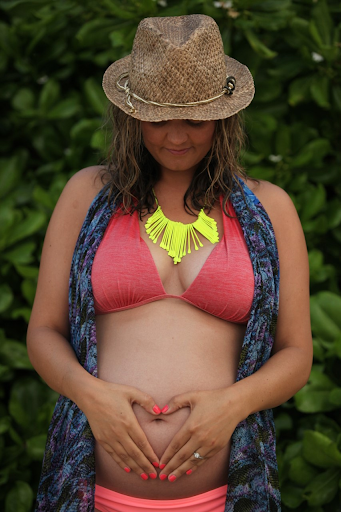4 Women Share How Pregnancy Affected Their Vitiligo

Living with vitiligo and currently pregnant or considering starting a family? You may be wondering if–and how–pregnancy may impact your vitiligo. While this subject isn’t widely studied, a 2021 survey of 28 women with vitiligo who experienced a total of 57 pregnancies showed that only 17.5% observed their vitiligo spreading during pregnancy, while 66.7% observed stability in their vitiligo, and 12.8% noticed repigmentation.
To offer more insight into what these experiences might be like, we interviewed four women with vitiligo who had various experiences with the condition before, during and after pregnancy. Here are their stories.

Erika Page on experiencing repigmentation of her vitiligo during two pregnancies
The founder and editor of Living Dappled, Erika Page was diagnosed with vitiligo at the age of seven and lost 100% of her skin’s pigment naturally over the course of twenty years. By the time Erika was first pregnant, she had been entirely depigmented for nearly a decade–and thought her journey with vitiligo was complete.
A few months before the birth of her first child, Erika started noticing repigmentation along her arms in the form of tiny freckles that continued to spread around her wrists and arms. In the last month of pregnancy, the freckles also appeared on her legs. Despite this change, just six months after her daughter was born, the pigmentation had reversed and Erika was back to being entirely depigmented.
“It took me a long time to feel comfortable in my fully depigmented skin, and the repigmentation in my first pregnancy was shocking,” said Erika, who didn’t know what to expect. “After my daughter was born, I had less time to think about it but I might have considered treatment to remove the pigmentation if it stayed.”
During her second pregnancy, just one year later, Erika experienced minimal repigmentation in the form of freckles on her wrists again. All of the repigmentation disappeared within a month of becoming visible on her skin–and her skin has remained depigmented since.
Bettina on the spread of pre-existing vitiligo during her two pregnancies
At age 25, white hair began emerging at the top of Bettina’s head that led to her vitiligo diagnosis. Vitiligo is commonly present in people with other autoimmune conditions, and Bettina experienced this firsthand as she was diagnosed with Hashimoto’s prior to pregnancy. During this time, her vitiligo was mostly stable on her feet, hands and hair. It wasn’t until the third trimester of her first pregnancy that Bettina began to notice a spread of depigmentation on her feet, hands, back and chest.
“Knowing the impact of pregnancy on the body, I have given myself the grace to accept that this is part of who I am and the price I am willing to pay for creating a family of my own,” Bettina shared as she reflected on the impact of motherhood on her skin. After finding out she was pregnant with her second child at age 33, she recalls that her vitiligo started spreading even faster and more aggressively–even developing on her face.
While the emotional impact of vitiligo, especially during pregnancy, can be immense, Bettina offers advice to anyone in a similar position who may be struggling.
“I think pregnancy is a challenge for a woman’s self-confidence,” said Bettina, noting that women go through a number of physical changes during this time, and that many of them can be unwanted. “Vitiligo spreading doesn’t add to self-confidence, when everything else is already making you feel unsure about yourself. By giving myself grace, I managed to handle this low in self-confidence.”

Nadia on developing vitiligo for the first time after pregnancy
Nadia developed vitiligo for the first time after her pregnancy. Following the birth of her first daughter in 2015, small, white patches appeared on Nadia’s fingers and chest. Following the advice of her dermatologist, she decided to wait to begin treatment until she was done having children. Near the end of Nadia’s second pregnancy, she noticed some white patches on her face–an occurrence she describes as deeply emotional.
“It’s always emotional seeing a new spot or seeing an existing spot expand, but even more so when it’s occurring at super speed when your body is already going through plenty of physical and emotional changes,” said Nadia, who believes the onset of her vitiligo was due to pregnancy.
Emily on the accelerated spread of her vitiligo during pregnancy
At just 14 years old, Emily was diagnosed with vitiligo. By the time she was in her thirties, vitiligo had spread to cover 35-45% of her body–until she had her children. Today, following the birth of her two children, 80% of her body is depigmented – a process she notes was accelerated after her second pregnancy. She began noticing spots in new places such as her torso, inner arms, and the back of her legs. However, unlike those who noticed the most changes during pregnancy, she witnessed the largest spread postpartum.
Medical Disclaimer: This information is intended for informational purposes only. Consult with your doctor or a professional healthcare provider for medical advice, treatment or diagnosis.
Savannah Fakhouri is a medical student who has been living with segmental vitiligo for 9 years. Her experiences motivate her to partner with patients and address the psychosocial impact of skin conditions while providing empowering, compassionate care. When not studying, she enjoys live music, exploring tide pools, hiking, and spending time with loved ones.


